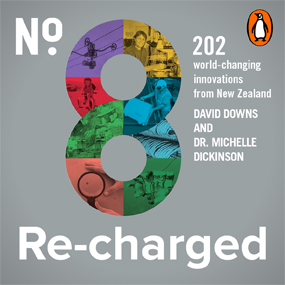It’s been one hell of a start to the year. I left you last in January at the gates of Parihaka and I feel like I’ve been foot down and motoring hard ever since. It’s now late March 2010. We’ve just finished the first stage of a clean-up after our fourth annual Waiohiki Hui & Huilli, Maori Irish St Paddy’s Day. It was a craic, a huge success. It’s our fourth year and we’ve developed a formula: classy kai, memorable performers, and compelling art for auction. We weave the charity auction through a menu of fine dishes, music, and an after-dinner speech – the annual Waiohiki St Patrick’s Day Address. This year the (fourth) Paddy’s Day Address was delivered by journalist Noelle McCarthy. Previous speakers have been Sir Anand Satyanand, Governor General, broadcaster Mark Sainsbury and Cabinet Minister Chris Finlayson. Our theme for 2010 was “Three chairs for nationhood in these Pacific Irelands”. Excuse the awful puns, but it is a Maori Irish event after all, and both sets of participants in our collective celebratory endeavour should be allowed some latitude when it comes to attempts at humour, especially on this sacred day.
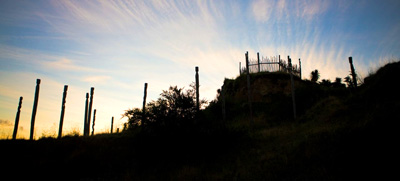
Otatara Pa – dusk at Maori Motown – Photo by: Richard Brimmer
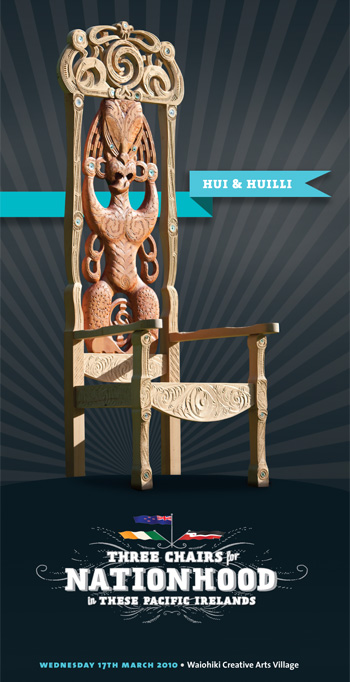
Kauri Throne
On the other hand we are very serious about fostering a sense of nationhood in Aotearoa New Zealand, and truly believe that the celebration of our differences, as is the Hui & Huilli, also underlines our connectedness and interdependence. We flew three flags – The ‘Tino Rangatiratanga’ Maori Flag, the New Zealand Flag, and the flag of the Republic of Ireland. And, we featured three chairs, one, crafted from recovered rimu, in the Cape Cod style (we dubbed it Capecodnappers), by “Wanderschaft” journeyman carpenter Mikey Williams, another, a corrugated iron “Settlers’ Chair” by Jeff Thomson, and the final piece, a kauri beam rescued from the old Whakatu meatworks transformed into a carved throne by Hugh Tareha and other members of the Pa Whakairo collective, Te Rangi Robins and John Nelson.
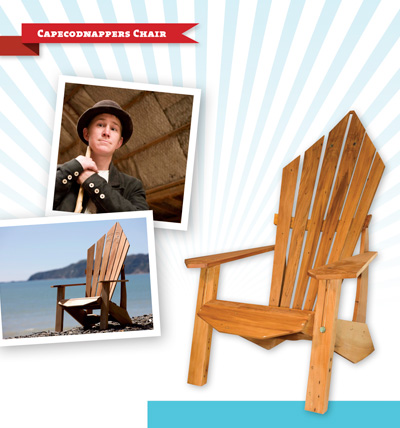
Mikey Williams, journeyman carpenter
Our auctioneer was Simon Tremain, younger brother of local Member of Parliament Chris, who was unable to attend because of duties in the House. We’d spent a week erecting scaffolding to create a make-believe Polynesian ‘fale’ out in the backyard near the kiln – thanks BLine – and lining it with bamboo. John Gisborne put in some of his water features and the night before the hui we had the lighting man in to help create the ambience. It all looked fantastic. Wouldn’t you know it – Murphy’s Law applied! On Paddy’s Day the weather turned to crap. A cold southerly blew through and the temperature plummeted. We had to reorient – move inside, empty out the Gallery and reset the whole blooming thing. Regardless of the quality of the music and kai no one will buy a thing if their arses are freezing off. Anyway, on the night all was good. Our mood musos – Matt Mear and Dave Boston – jazzed away in the background, and the young people from the Waiohiki Youth Development Programme moved around serving the guests with canapés and other finger food. Some of these kids can be as rough as guts, troubled homes and dangerous lifestyles and all that, but they get flashed up, and, with a bit of schooling from Aunty Maia morph into charming waitresses and waiters. In fact they become part of the buzz – the well heeled patrons enjoying putting some shine on these rough diamonds as they chat and interact. My role at these events is as MC and, after I had welcomed the guests and explained the kaupapa, my god-daughter Amokura Hutana and her cousin Ngahuia Harris sang the assembly into the mood to buy.

Amokura Hutana
The event took another step up the mood ladder after the main course was served. Noelle Mc Carthy spoke.
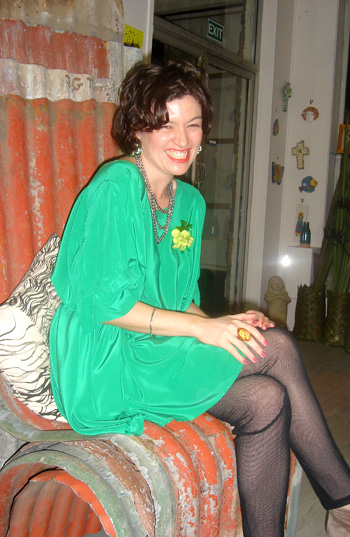
Noelle McCarthy on Jeff Thomson’s Settlers’ Chair
This fine looking colleen charmed us all with her wit, the lilt of her mellifluous voice, and her general vivacity. I just about go into a fetal ball every time I hear her speak – it triggers some hearthside memory from my infancy. Its like being cuddled. And, I might say, most of the males in the room may have been thinking of a cuddle or two with Noelle in a rather more adult dimension. Be that as it may, Noelle, splendid in green evening dress and bright red high heels had our collective attention. She used a trinity of reo, Gaelic, Maori, and English, underlining at the same time both our points of difference, and the cultural crossing points of our connectedness: the things that bind us. Moreover, besides being erudite she was funny. In discussing the matter of St Patrick’s true birthplace Noelle proposed that St Patrick was in all likelihood a Kiwi by birth, and provided a number of facts that have led her to this remarkable conclusion (including his relationship with sheep). It was hilarious. And, as an equal quality relish to her korero, our souls were uplifted by the remarkable Elena, Ngati Kahungunu violinist extraordinaire. Elena’s entry into the venue was signaled by a haunting karanga and, then, herself present, playing a baroque classic, Johannn Pachelbel’s Canon (in D Major).
Elena can be startling at first sight, shaven head topped by a high Mohawk. This night the diva was wearing a dramatic Elizabethan gown. Her eyes blazed and her gaze engaged each member of the audience as if in a private exchange. Her face was lit by a crescent smile and she used subtle, ever changing, facial expressions to underline the score. She triggers emotions. Some people had tears in their eyes. Elena played further, ‘Sway’ by Bic Runga (another performing artist with whakapapa links to Waiohiki), and, perhaps in a slightly self mocking way, “The Last of the Mohicans” – this, because as Elena reckoned, it ends with an Irish fiddle motif. Her performance was spine tingling. The tears had turned to broad grins of delight. I’m telling you, after this set the bidding went spastic. We sold everything on offer, and some, nearly $40,000 worth of art in total including the kauri throne which was purchased by Kevin Roberts, philanthropist of New York. I was rapt.
In February we held an event in the Otatara amphitheatre, the ancient Pa site that rises above Waiohiki. If you are a regular reader of these columns you’ll know that my mission for 2010 is to build a local movement to get help for individuals and whanau confronting methamphetamine addiction. Otatara has a certain healing wairua about it. Because of Joe Walsh’s experience there its become a beacon for those seeking refuge from the consequences of human problems like substance addiction, in particular methamphetamine. There are places that seem to transmit a sense of healing, or connect us with another plane of consciousness – a ‘higher power’ as the ‘12 Steps’ puts it. Otatara is one of them and that’s why I chose it as our venue.
When you have few resources at your disposal, other than time and intelligence, you’ve got to think of ways of getting your kaupapa heard above the wall of chatter (shades of Phil Spector). In February every year one of the big local events is the Mission Concert. For 2010 the Mission theme was ‘Motown’. I thought I might be able to come in on the shoulder of the Mission event, and use a form of ambush marketing to ride on the huge wave of interest it always creates. The Mission event tends to be a bit of a piss-fest and tickets are expensive. I thought what about using the Motown theme, mounting an alcohol-free event, making it affordable for families, and pushing our ‘you can beat meth’ kaupapa? Otatara is a profoundly Maori venue so I conjured up the idea of a ‘Maori Motown’ planning to use Maori artists and perhaps songs in Te Reo Maori. Because we had the underlying ‘you can beat it’ kaupapa to push we framed the event as ‘Maori Motown (with a message)’.

There is no doubt that times are tough when it comes to raising bucks – an event like this is never going to be self-sufficient and sponsorship is required. It is also true that community crises, and methamphetamine has presented New Zealand with a crisis, make for strange bedfellows. Just like I never expected that the Mongrel Mob Notorious and the Sallies would team up, I never expected that I’d end up working alongside the Rotary Club-based ‘Stellar Trust’. I’ve been getting to know Stellar CE Mike Williams over recent months and Mike convinced his Board to give us a go. With a foundation sponsor on board we managed to convince others, the Mad Butcher, Te Puni Kokiri, the Hawke’s Bay DHB, the Ministries of Health and Social Development and the New Zealand Drug Foundation to put in modest sums. Chris Tremain MP helped us with a marquee and convinced a local farmer to loan us hay bales for seating. Prime Minister, John Key sent a letter of encouragement. The Heretaunga Taiwhenua helped out too. And so it went, people and organizations pitching in for the cause. The clincher came when Paul Holmes agreed to speak. I’d already signed up Frankie Stevens to sing. The brother and I are close enough for me to know that even if I can’t pay him he’ll still do a show for me, and you need to have some artists to bring in the others. Jo Paku agreed to produce the show, and she came up with a marvelous line up – opera singer Wiremu Winitana as MC, Frankie and backing vocalists with a Motown set, Brannigan Kaa doing James Brown numbers, Rewa Ututaonga as Aretha Franklin, Thomas Stowers as Barry White, and the Ernie Semusu Maori Motown Band. The boys spent the best part of two months getting the venue into shape.
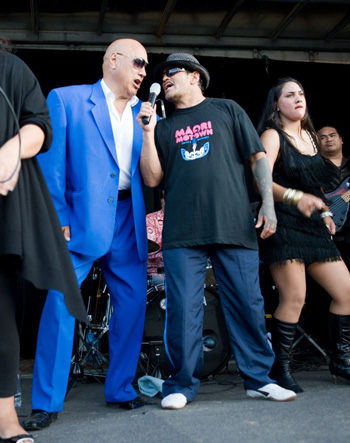
Frankie Stevens and Brannigan Kaa
We created a whole new walking track and manicured the place to a standard it hadn’t enjoyed for many years. One the eve of the event we had a rain bomb that dumped two months rain in two hours. The road up to the pa turned to weetbix. The portaloo truck got stuck halfway up the accessway and I thought we were going to be literally in the crap. Then we couldn’t get the stage trailer up. We had to improvise. A curtainsider truck, twenty apple crates, and a bit of flooring and carpet fixed that problem. The day of the event was warm, kind, and mild. By the evening’s end we had about 1400 patrons, mainly families, but amongst them a large number of people struggling with meth. We held firm to our no alcohol and (polite) no patches policy.
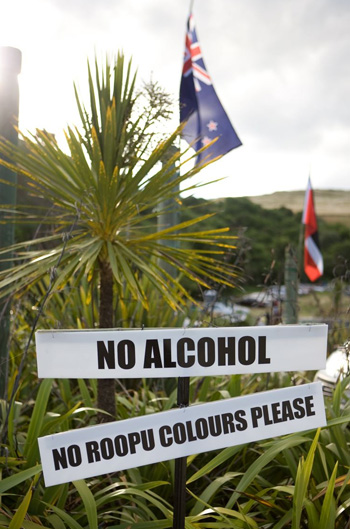
Paul Holmes spoke early in the evening. He showed his heart, wearing it on his sleeve, and his sincerity reached every listener. His honesty reminded us that wealth and fame give no protection when meth comes visiting the whanau home. My respect for the man grew by the hour. When we were organizing the event I’d tried to get the Sunday papers to give us a bit of promotion. Paul’s address was the hook. But whilst the papers will go to the ends of the earth to write up anything salacious to do with him or Millie they wouldn’t give us a column inch when it came to featuring him at work beating the scourge of methamphetamine addiction. One of our local heroines Kate O’Brien, a registered nurse, also spoke, telling of her battle with methamphetamine and her ultimate victory over it, with the love and support of family. So there was this mix of korero and fantastic music, extraordinary voices in an awe inspiring venue. It was a great night and people are still talking about it. We’d prepared a little takeaway, a mock up of a 45rpm record with a message of hope, a promise that we’d keep meeting at Otatara on a regular basis to celebrate victories over meth, and some places to get information and help, as required.

Maori Motown has catalysed some excellent community action. There is a movement abroad in the Hawke’s Bay, and I’ve attended three hui since, all of which propose a common methamphetamine related agenda: wind down the hype and the demonization of users; increase the clinical treatment and other addiction recovery services; and support whanau confronting methamphetamine. Another positive shot in the arm – maybe not the best metaphor – was an email from Joe Walsh’s accountant from the USA. Joe wanted to contribute – and has since done so – $US5,000 towards our project. So, we’re running Joe Walsh Sundays at Otatara pretty much on a monthly basis. We’ve held our first – a small turn out – and our next is the Sunday after Easter. I’ll be a bit more diligent than lately in keeping you up with progress, but, mark my words, as a province Hawke’s Bay will lead the way in combating methamphetamine.
Well I started this edition of the blog nearly a month ago, on the evening of 28th February 2010, the end of a long but essentially sunny day. The phone had gone at 5.30am. It was Hera. There had been a big earthquake in Chile and there was a tsunami alert throughout the Pacific. Edgar Schein talks about Anxiety One – the’ frozen’ anxiety, where you sit like a possum in the face of oncoming headlights – and Anxiety Two – the motivating ‘get off your arse’ anxiety, that inspires cause and effect thinking and figures out a plan of action for specific situations. I suffer from the latter, Anxiety Two. Along with the others in our community, who also choose to organize for times of adversity, I’m part of a local team with a civil defence plan. In the event of a tsunami threat to Ahuriri my first job is to open the gates of Otatara. Just as their ancestors did, the local hapu take to the hills when a threat is imminent (its not only a place for music or reflection on our addictions). At that hour of the morning there is still a bar across the reserve road so it means calling Armourguard who hold the key. I reckon, in such circumstances, my days as the communications manager for the Department of Internal Affairs, and handling the Government’s media in times of Civil Defence crises, have added a certain gravitas to my voice. Even though the Armourguard operator was initially “who the? what the?” a mobile patrol car was duly dispatched and our refuge open ready to do play its ancient and comfort-giving role. By 8.30am or so a steady trickle of vans and cars were making their way up the Pa road, and various whanau were setting up their bases. They had supplies of water and food and shelter, and were ready for whatever eventuated. Now I appreciate that there is a school of thought that says this sort of response is a waste of time, an overreaction. But just like responding to smoke alarms or following fire drills its on about survival. Some of the whanau hedge their bets. They dispatch one vehicle packed with their emergency rations and equipment and the most vulnerable members of the whanau – the very young and the elderly – whilst the others continue with their work or planned activities, keeping an ear tuned to the radio for civil defence alerts. It’s a risk mitigation approach and presents an intelligent balance between what we know and what we imagine. Our Waiohiki plan works because people play their designated roles. This gives a sense of comfort, and is a sign of community strength and resilience. I like it.
In times of trouble haere ki Otatara
Well looking beyond the sunny skies of Hawke’s Bay and at the country at large it seems that the rod of pharaoh is to be lashed more heavily on the backs of the poor. MP Paul Quinn has a Private Member’s Bill before the House which aims to remove the right to vote for those in prison. It is another layer of the skin of citizenship being stripped from the tribe of Nga Mokai to add to differential penalties; denial of the right to assemble freely; denial of State housing; and most significantly, denial of the presumption of innocence. Apparently the Community Max programme, which I have previously lauded because it gives a crucial opportunity for work to 16-24 year olds, is about to be scrapped. Meanwhile longterm beneficiaries are to be delivered “a kick in the pants”. The “dream” Social Development Minister Paula Bennett has told our beneficiaries, “is over”. She wants to start with solo mums.
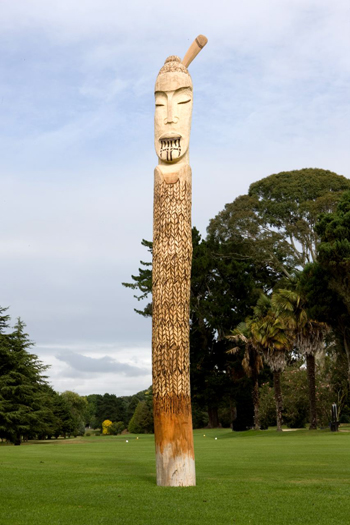
‘Solo mum’. Pou Waahine – carver Janet Spooner
Never mind the fact that we have our highest levels of unemployment in a decade, the (implicitly) undeserving are required to get off the imagined comfortable mattress of the dole or domestic purposes benefit and head out into the job market to fend for themselves and their dependants. This, apparently, is to break the cycle of dependency. There is no dream in being a beneficiary – it’s more akin to a nightmare, a horrible place and a horrible time. Something will be broken all right, most likely the spirit of beneficiaries. There is a pattern to the current swathe of initiatives that track across the criminal justice and social welfare sectors. They focus on the tribe of Nga Mokai. The roll out of tasers is well underway, and at the same time, regardless of the concerns expressed to our Government by the United Nations, the reporting requirements for their use have been loosened. Police officers are no longer required as a matter of course to explain the circumstances in which they draw and or use this potentially lethal sidearm. The Minister of Police said that she didn’t want to constrain officers – didn’t want them to have to think twice before they drew their weapon. At the same time there has been outrage at attacks on Policemen and a suggestion that getting in a fight with a Policeman should be considered as a ‘three strikes’ offence. Cops do physically pick on people you know, particularly young people and brown people, and heaven help it if you are both. Take the case, for instance of Rawiri Falwasser who althought never having been previously in trouble with the Police was arrested on suspicion of stealing a car and taken to the Whakatane Police Station. There he was beaten with batons to the degree that his head was split open with a 6cm cut. Then he was pepper sprayed 65 times over a period of 20 minutes by four angry cops. In 2006 a local jury found the cops not guilty of assault, but, recently, in the High Court in Auckland, Justice Stevens ruled that Falwasser was clearly assaulted by police in an abuse of power that was “unnecessary, unjustified and without lawful authority”. He found that there was a serious breach of the New Zealand Bill of Rights Act and awarded the lad $30,000 in damages. Just before Christmas I know of an instance where the Police pulled up a car for an inspection. That was fair enough – but one of the constables went on to engage in banter with the young occupants and ended up telling them, three times, that if he ever had the chance he would shoot them. I know youthful lip can be annoying but such a provocative response is silly, self defeating and dangerous to other members of the Police. The kids take this stuff seriously, and, “we’ll get you first” is an understandable response. Respect for the Police arises from the Police respect for the community. If the Police don’t show respect for the young, and in particular the young and brown, then they will reap disrespect. And if the Police gear up with tasers, and are given some ‘untouchable’ status when it comes to physically resisting their bullying, then we set a scenario for youthful rebellion.
A week or so ago a gang dad approached me and told me that he and his whanau were just about at explosion point over the treatment of their young people by the Police. They live in a rural centre and they feel the Police target these kids because their parents are in a gang – despite the fact that the parents work in good jobs and the family lifestyle is for all intents and purposes virtually middle-class. An example advanced by these families include an instance where a son was arrested on what sounded like a spurious charge and subject to very firm parole conditions including visits to the family home at all hours of the day and night. This went on for over a year, and then the charges were withdrawn on the eve of the case finally going to a hearing. Following another recent event, the beating of a son by the Police, these whanau were so fired up that they were on the verge of what may well have become counter-productive action. One of the older brothers told me they needed to speak to someone urgently and asked if I could get them access to Hone Harawira who they felt had the integrity and courage to champion their cause. I asked Hone, and within a week he had agreed to meet with the whanau and listen to their grievances. It was an encouraging event. They put their case articulately and passionately.

Whanau values prevail
But the most encouraging aspect of the hui – held at a family member’s home – was the pro-social ambience and welcoming whanau behaviour. The male adults may well have been wearing patches but all else was of a garden variety in terms of a Maori whanau living in suburban New Zealand. We sat outside on a barbecue table. Well dressed and obviously well cared for children played around the yard. Visitors were respectfully greeted as ‘uncle’ or ‘koro’ or whatever. Kai was served – a roast, supplemented by kai moana and other delicacies.
One of the young people – perhaps 15 years of age or so – was asked to say grace, and he did so in Te Reo Maori. After kai speeches of gratitude were made from both sides, visitors and the hau kainga. A haka of tribute was done by the entire whanau as a tribute to Hone. The exercise wasn’t just discursive and placatory. We concluded that in light of the creeping fascism and increasing use of Pharoah’s Rod it’s time to go back to the tools that we used when we were on the street in the 1970’s. Our old man Peter Williams QC has retired. Shirley Smith is dead. It’s time to relight the fire under the New Zealand Council for Civil Liberties, time to dust the cobwebs off those local United Nations and Human Rights networks, and time to reinvent PIG, the Police Investigation Group. It is autumn. Easter is close by and we look forward to the Resurrection. A seasonal change is afoot. Look lively now!
The light of a new morning is bright on the grass
And the voices of the poor are welcoming the day
When the cloud of night will be lifted and pharaoh’s kingdom gone
Alleluia. AdonaiJames K Baxter Song to the Lord God on a Spring Morning.
Arohanui. D







